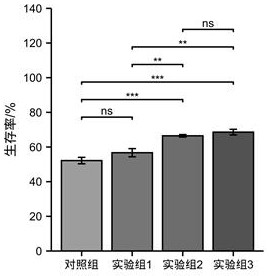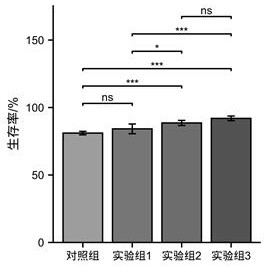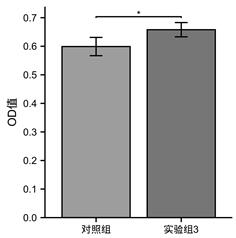A cryoprotectant for ultra-low temperature injury of mesenchymal stem cells
A cryopreservation agent and mesenchymal stem cell technology, which is applied in the field of cryopreservation agent for mesenchymal stem cells damaged by ultra-low temperature, can solve the problems of decreased cell activity, affecting the proliferation and differentiation ability of umbilical cord blood mesenchymal stem cells, etc., and achieve the purpose of providing activity Effect
- Summary
- Abstract
- Description
- Claims
- Application Information
AI Technical Summary
Problems solved by technology
Method used
Image
Examples
Embodiment 1
[0028] Detection of the effect of ranacyclin B3 polypeptide pretreatment on the cryopreservation viability of umbilical cord blood mesenchymal stem cells
[0029] 1. Cell Treatment
[0030] (1) Experimental groups: control group (use DMEM / F12 medium to treat umbilical cord blood mesenchymal stem cells for 2 hours), experimental group 1 (use DMEM / F12 medium containing 25 μmol / L Ranacyclin B3 polypeptide to treat umbilical cord blood mesenchymal stem cells 2h), experimental group 2 (umbilical cord blood mesenchymal stem cells were treated with DMEM / F12 medium containing 50 μmol / L Ranacyclin B3 polypeptide for 2 hours), experimental group 3 (treated with DMEM / F12 medium containing 100 μmol / L Ranacyclin B3 polypeptide Umbilical cord blood mesenchymal stem cells 2h);
[0031] (2) Prepare cryopreservation solution according to 10% DMSO, 50% FBS, 40% DMEM / F12 medium;
[0032] (3) Collect the cells treated in step (1), add cryopreservation solution, and divide into cryopreservation ...
Embodiment 2
[0045] Detection of the effect of ranacyclin B3 polypeptide pretreatment on the proliferation activity of umbilical cord blood mesenchymal stem cells
[0046] (1) Take out the cells of the control group and experimental group 3 that were frozen in liquid nitrogen for 12 months, put them in a 37°C water bath to quickly melt and recover, and centrifuge to remove the supernatant;
[0047] (2) Seed the cells in a 6-well plate. After the cells adhere to the wall, remove the floating dead cells, add trypsin to digest the cells and adjust the cell concentration of each group;
[0048] (3) Add 100ul 1×10 5 The cells were seeded in a 96-well plate, and after 3 days, 10ul CCK-8 was added to detect the OD value of the cells.
[0049] Experimental results such as image 3 As shown, the average OD value of the control group was 0.599, and the standard deviation was 0.032; the average OD value of the experimental group 3 was 0.658, and the standard deviation was 0.025, P<0.05. Blood mese...
Embodiment 3
[0051] Detection of the effect of ranacyclin B3 polypeptide pretreatment on the adipogenic differentiation ability of cryopreserved umbilical cord blood mesenchymal stem cells
[0052] (1) Take out the cells of the control group and experimental group 3 that were frozen in liquid nitrogen for 12 months, put them in a 37°C water bath to quickly melt and recover, and centrifuge to remove the supernatant;
[0053] (2) Cells were seeded in a 6-well culture plate. When the cell confluency reached 90%, the adipogenic induction medium I was cultured for 2 days, then replaced with adipogenic induction medium II, and the culture was continued until the 8th day. Replace the culture medium once a day;
[0054] (3) After the culture, remove the medium, wash the cells with PBS 3 times, and add 10% formaldehyde to fix the cells for 40 min;
[0055](4) After removing formaldehyde, add 500ul Oil Red O staining solution and stain at room temperature for 30min;
[0056] (5) After removing the...
PUM
 Login to View More
Login to View More Abstract
Description
Claims
Application Information
 Login to View More
Login to View More - R&D
- Intellectual Property
- Life Sciences
- Materials
- Tech Scout
- Unparalleled Data Quality
- Higher Quality Content
- 60% Fewer Hallucinations
Browse by: Latest US Patents, China's latest patents, Technical Efficacy Thesaurus, Application Domain, Technology Topic, Popular Technical Reports.
© 2025 PatSnap. All rights reserved.Legal|Privacy policy|Modern Slavery Act Transparency Statement|Sitemap|About US| Contact US: help@patsnap.com



